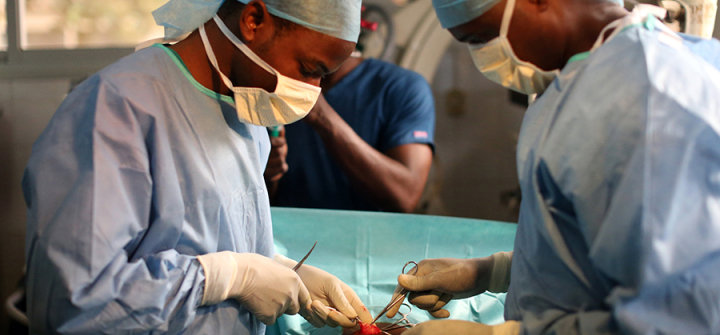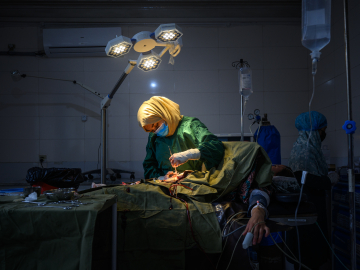To Prepare for Pandemics, Invest in Surgical Care
Sufficient treatment capacity during pandemics like COVID-19 saves lives. The idea behind “flattening the curve” is to keep the number of sick patients below the existing capacity for treatment.
We want to avoid, at all costs, a situation where a person who needs critical medical treatment—like a ventilator—is unable to receive it. Sadly, that is precisely what has happened in some places in the world, including the US. And as some cities braced for the surge by frantically trying to increase treatment capacity, the most valuable asset is turning out to be existing surgical capacity.
From a pandemic readiness point of view, strengthening surgical care represents a “best buy” in achieving a key objective of increased treatment capacity.
Surgical subsystems, with its Space (operating rooms, pre- and post-op rooms, ICUs, and wards), Stuff (personal protective equipment, ventilators, sterilization equipment, etc.) and Staff (surgeons, anesthesiologists/anesthetists, nurses, trainees etc.), can be quickly converted to care for patients in pandemics like COVID-19. According to McKinsey & Company, health systems in high-income countries can immediately increase up to 30% in treatment capacity by halting non-emergent care such as elective surgeries. And, due to social distancing measures, the number of emergency surgical cases go way down. The reduction in emergencies, combined with the postponing elective surgical cases that can wait, frees up the surgical capacity even more.
While countries with robust health—and surgical¬—systems are already employing these strategies, the story is dramatically different in the low- and middle-income countries. It turns out that only 6.3% of all the operations performed each year worldwide occurs in these countries. In other words, these health systems simply do not possess the surgical capacity to tap into during pandemics. But there is some good news. Since the unanimous passage of the 2015 World Health Assembly resolution 68.15—calling for strengthening of emergency and essential surgical care and anesthesia as a component of universal health coverage—over 44 LMICs are undertaking countrywide surgical strengthening planning and implementation. The time to fund surgical system strengthening in LMICs could not be better.
The Harvard Program in Global Surgery and the WHO have produced a framework for strengthening surgical care in LMICs using a health systems approach. Using this framework, many LMIC countries have created national strategic plans for expansion of surgical, obstetric, and anesthesia services. Adding a pandemics preparedness dimension to the framework is a matter of incorporating how the newly built capacity can be repurposed for pandemic or even disaster response when needed. Furthermore, having a strategic and operational plan for surgical capacity building assures funders of pandemic readiness that the resources will be used in a systematic approach with built in accountability and metrics.
What we should avoid is a situation where money is disbursed to a country for purchasing hundreds of ventilators without a strategic plan that includes workforce scale up, training, and infrastructural investments, in the name of pandemic preparedness and health system strengthening.
To be sure, investing in LMIC surgical systems is not the panacea for pandemics, and system level changes are inherently slow processes. The benefits will not be realized overnight but rather incrementally as the systems are built up. Nevertheless, investing in surgical systems in LMICs represents a best buy considering the flexible nature of these systems. Conditions such as injuries, obstetric emergencies, congenital malformations, cancers, and strokes are well served by a robust surgical system. In fact, 30% of the global burden of diseases are surgical. In addition to strengthening the health systems, these surgical systems will also play a critical role in managing surges during pandemics when needed.
The time is right with many of the LMICs having committed to strengthening surgical care. Once completed, these new surgical systems will help reduce the massive backlog of surgical cases in these countries and, more importantly, prevent deaths and disabilities by availing timely, safe, and affordable surgical care when needed.
The added treatment capacity will increase the level of health security for these countries as they try to respond to the current and future pandemics.
Kee B. Park, MD, MPH, is the Paul Farmer Global Surgery Scholar in the Program in Global Surgery and Social Change at Harvard Medical School. Twitter: @keepark
For GHN's latest coverage of the coronavirus, visit here.
And, please send GHN any questions you'd like to see answered related to the coronavirus outbreak. Just email Dayna (dkerecm1 at jhu.edu).
Join 50,000+ subscribers in more than 170 countries who rely on Global Health NOW summaries and exclusive articles for the latest public health news. Sign up for our free weekday newsletter, and please share our free subscribe link with friends and colleagues.
Surgeons operate in a hospital in Sotouboua, Togo. Image: BSIP/Universal Images Group via Getty Images





